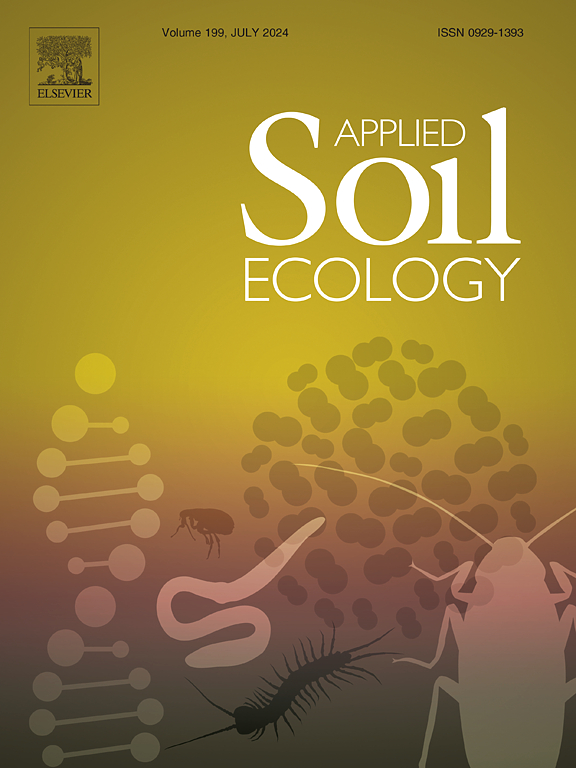Liming mitigates earthworm-induced CO2 and N2O emissions from a sugar maple (Acer saccharum Marsh.) forest soil
IF 4.8
2区 农林科学
Q1 SOIL SCIENCE
引用次数: 0
Abstract
Sugar maple (Acer saccharum Marsh.) forests in southern Quebec (Canada) are used for multiple human activities, with potential impacts on soil greenhouse gas emissions. Here, we studied the principal and interactive effects of three anthropogenic factors, namely (1) changes in leaf litter quality due to stand conversion, (2) application of dolomitic lime, and (3) the introduction of non-native earthworms, on soil CO2 and N2O emissions and related soil properties. These three experimental factors were arranged in a 2 × 2 × 2 factorial array to obtain eight treatments that we replicated four times in a complete randomized block design. Treatments were applied to mesocosms containing sugar maple forest soil and incubated for 15 months, during which we monitored soil CO2 and N2O emissions. At the end of the trial, we sampled soils at four depths and measured pH, mineralizable nitrogen, soil aggregate stability (WSAI), δ13C, and mineral-associated organic matter (MAOM). Liming reduced CO2 emissions across all earthworm × litter-type combinations. By contrast, earthworms increased CO2 only when combined with the sugar maple-American beech (Fagus grandifolia Ehrh.) litter mixture. Both liming and earthworms increased WSAI. However, we found a negative relationship between WSAI and cumulative CO2 in soils (0–20 cm depth) without earthworms, but a positive relationship between these two variables in soils without liming. These two contrasting relationships highlight the biochemical differences in aggregates formed by liming and those formed by earthworms. Earthworms increased both nitrification and N2O emissions whereas liming increased soil pH while reducing the positive effect of earthworms on N2O. We found no treatment effects of either δ13C or MAOM. We conclude that the spread of non-native earthworms in sugar maple forests of southern Quebec will potentially increase soil N2O and CO2 emissions, but these could be mitigated by liming.
石灰化减轻了蚯蚓诱导的糖枫(Acer saccharum Marsh.)森林土壤中的CO2和N2O排放
加拿大魁北克南部的糖枫(Acer saccharum Marsh.)森林被用于多种人类活动,对土壤温室气体排放有潜在影响。本文研究了3个人为因子(1)林分转换引起的凋落叶质量变化、(2)白云石石灰的施用和(3)蚯蚓的引入对土壤CO2和N2O排放及相关土壤性质的主效应和交互效应。这三个实验因素被安排在一个2 × 2 × 2的因子数组中,得到8个处理,我们在一个完全随机区组设计中重复了4次。对含糖枫林土壤的中生态系统进行处理,培养15个月,监测土壤CO2和N2O排放。在试验结束时,我们在4个深度取样土壤,测量pH、矿化氮、土壤团聚体稳定性(WSAI)、δ13C和矿物伴生有机质(MAOM)。石灰减少了所有蚯蚓×凋落物类型组合的二氧化碳排放量。相比之下,蚯蚓只在与糖枫-美洲山毛榉(Fagus grandfolia Ehrh.)凋落物混合时才增加二氧化碳。石灰和蚯蚓均增加了WSAI。在不加蚯蚓的0 ~ 20 cm土壤中,WSAI与累积CO2呈负相关,而在不加石灰的土壤中,二者呈正相关。这两种对比关系突出了石灰化和蚯蚓形成的团聚体的生化差异。蚯蚓增加了硝化作用和N2O排放,而石灰增加了土壤pH值,降低了蚯蚓对N2O的积极作用。我们没有发现δ13C或MAOM的处理效果。我们的结论是,在魁北克南部的糖枫林中,非本地蚯蚓的传播可能会增加土壤N2O和CO2的排放,但这些可以通过石灰来缓解。
本文章由计算机程序翻译,如有差异,请以英文原文为准。
求助全文
约1分钟内获得全文
求助全文
来源期刊

Applied Soil Ecology
农林科学-土壤科学
CiteScore
9.70
自引率
4.20%
发文量
363
审稿时长
5.3 months
期刊介绍:
Applied Soil Ecology addresses the role of soil organisms and their interactions in relation to: sustainability and productivity, nutrient cycling and other soil processes, the maintenance of soil functions, the impact of human activities on soil ecosystems and bio(techno)logical control of soil-inhabiting pests, diseases and weeds.
 求助内容:
求助内容: 应助结果提醒方式:
应助结果提醒方式:


